Civil Justice Statistics Quarterly: July to September 2022
Published 1 December 2022
Applies to England and Wales
We are currently conducting a user consultation on these statistics. If you are interested in offering your views on this publication and future developments, the survey can be found here. This consultation will run until 1st March 2023.
1. Main Points
| Decrease in County Court claims, driven by money and damages claims | Compared to the same period in 2021, County Court claims from July to September 2022 were down 4% to 389,000. Of these, 317,000 (82%) were money claims (down 5%). Compared to the same quarter in 2019 (pre-covid baseline), County Court claims were down 29%. |
| Damages claims were down 24% at 26,000 | The decrease in damages claims was driven by a continued fall in Other Damages claims (down 59% to 5,500) compared to the same quarter in 2021. Compared to the same quarter in 2019 (pre-covid baseline), total damages claims were down 17%. |
| The number of claims defended and the number of trials decreased compared to 2021 | There were 61,000 claims defended (down 14%) and 13,000 claims that went to trial in July to September 2022 (down 5%) compared to the same quarter in 2021. Compared to the pre-covid baseline, claims defended were down 22% and claims that went to trial were down 24%. |
| Mean time taken from claim to hearing has increased | The mean time taken for small claims and multi/fast track claims to go to trial was 51.2 weeks and 75.5 weeks, 0.6 weeks longer and 4.8 weeks longer than the same period in 2021 respectively. Compared to 2019, these measures are 13.1 weeks longer for small claims and 16.2 weeks longer for multi/fast track claims. |
| Judgments were down 21% and default judgments were down 22% | Judgments were down 21% (to 225,000) in July to September 2022, compared to the same period in 2021; with 91% of these being default judgments. Compared to the same period in 2019, judgments were down 34%, 89% of which were default judgments. |
| Enforcement applications and orders fell to 12,000 and 8,300 respectively | Enforcement applications were down 19%, while enforcement orders were also down 22% when compared to the same quarter in 2021. Compared to 2019 (pre-covid baseline), volumes of enforcement applications were down 52% and enforcement orders were down 50%. |
| Warrants issued increased to 76,000 | Warrants issued were up 11% when compared to the same quarter in 2021 and down 31% compared to 2019 (pre-covid baseline). |
| 640 judicial review applications in Q3 2022 | There were 640 applications for Judicial Reviews in Q3 2022, up 16% on Q3 2021. Of the 130 cases in 2022 Q3 that have so far reached the permission stage, 8 (6%) were found to be ‘totally without merit’. |
This publication gives civil county court and judicial review statistics for the latest quarter (July to September 2022), compared to the same quarter in 2021. Should users wish to compare the latest outturn against 2019 as a pre-covid baseline, or to a time period during the covid period, they can do so using the accompanying statistical tables. For more details, please see the supporting document.
Statistics on the Business and Property Court for England and Wales have also been published alongside this quarterly bulletin as Official Statistics. For technical detail, please refer to the accompanying support document.
For general feedback related to the content of this publication, please contact us at: CAJS@justice.gov.uk
2. Statistician’s comment
Volumes across most civil actions have fallen this quarter compared to the same period in 2021. It is too early to say if the post-covid recovery has peaked but it seems trends are beginning to stabilise.
Overall, total claims issued have remained relatively stable this quarter, driven by money claims which make up 82% of these. Personal injury claims are showing early signs of stabilising following general decreases since Q2 2021. On the contrary, other damages claims have continued to fall following steep rises as a result of increases in PPI-related claims which appeared to peak in Q3 2021. However, these volumes remain above levels prior to this sharp rise.
Non-money claims continue to show recovery following the impact of Covid-19, driven by sustained increases in Mortgage and Landlord claims and those for return of goods, with the latter now above pre-pandemic levels. It is not yet clear why claims for return of goods have continued to rise but we will keep monitoring this trend. On the other hand, other non-money claims continue to fall, partly as a result of whiplash reforms reducing the volume of road traffic accident claims going to court.
The number of small claims trials heard this quarter increased to the highest level since Q1 2021. This is likely to be due to courts returning to pre-pandemic levels of listings as restrictions eased.
Timeliness figures have remained relatively stable since Q1 2021. Although measures implemented following the pandemic, such as the opening of Covid-secure courtrooms and the increase in remote hearings, benefited later cases and contributed to this stabilisation, we expect timeliness measures to be impacted for as long as cases stayed during the pandemic remain in the caseload.
3. Claims Summary
County court claims were down 4% on the same quarter of 2021, driven by money claims.
There were 389,000 County Court claims lodged in July to September 2022. Of these, 344,000 (88%) were money and damages claims (down 6% from July to September 2021).
Non-money claim volumes were at 45,000, up 21% when compared to the same quarter in 2021.
Mortgage and landlord possession claims were up 89% over the same period to 25,000, ‘other non-money claims’ were down 22% to 17,000 and claims for return of goods were up 45% to 3,100.
Figure 1: County Court claims by type, Q3 (July to September) 2017 to Q3 (July to September) 2022 (Source: table 1.2)
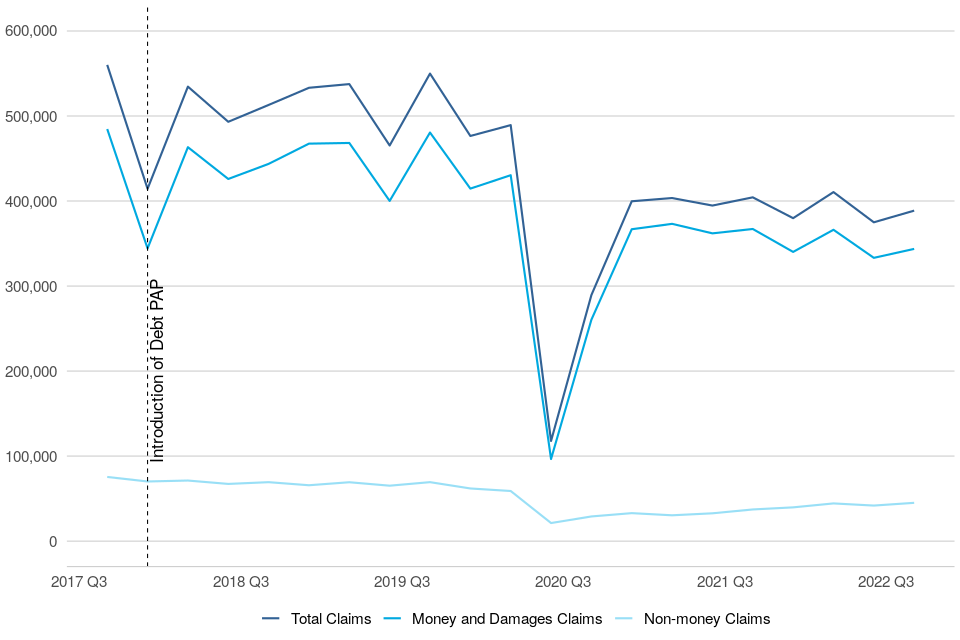
In the most recent quarter, total claims were down 4% compared to the same period in 2021 (from 404,000 to 389,000). Of these, 344,000 were money and damages claims, down 6% from July to September 2021 (from 367,000). Money and damages claims made up 88% of all claims in July to September 2022, down 2pp on its share in July to September 2021.
Prior to 2020, claim volumes had been relatively unchanged but volatile, driven by a few “bulk issuers” slowing down and then ramping up their volume of claims. Claim volumes decreased significantly following the outbreak of Covid-19. After an initial recovery towards pre-pandemic levels in the second half of 2020, volumes have remained relatively stable since Q1 2021, however, still down 29% compared to the same quarter in 2019.
Non-money claims have been generally decreasing since 2015. While these showed less of an impact following Covid-19 in contrast to money and damages claims, the recovery to pre-Covid19 volumes has been slow. In the current quarter, these claims were up 21% (from 37,000 to 45,000) compared to the same period in 2021, driven by increases in Mortgage and Landlord Possession claims. However, these remain down 35% below the same quarter in 2019 (pre-covid baseline).
Within non-money claims, ‘other’ non-money claims have shown a decline since 2018. In the most recent quarter, these were down 22% (from 22,000 to 17,000) compared to the same period in 2021. These continued decreases are partly as a result of whiplash reforms reducing the volume of road traffic accident claims going to court.
The overall trend in Mortgage and Landlord Possession claims has been decreasing since a peak of 60,000 in January to March 2014. Following the impact of Covid-19, these have increased gradually with 25,000 claims in July to September 2022, up 89% compared to the same quarter of 2021 (13,000 claims). Further details can be found in the Mortgage and Landlord Possessions publication here.
Claims for return of goods increased steadily to a high of 3,500 in July-September 2018 but have since declined. Following a further decline due to the impact of Covid-19, there has been continued recovery in these figures with volumes up 45% (from 2,200 to 3,100) in July to September 2022 compared to the same period in 2021. It is not yet clear why claims for return of goods have continued to rise but we will keep monitoring this trend.
4. Money Claims
Money claims were down 5% (to 317,000 claims) in July to September 2022 compared to the same quarter in 2021.
Money claims of up to (and including) £500 were down 6% over this period to 143,000, driving the overall trend in money claims.
Damages claims were down 24% at 26,000 driven by continued decreases in Other Damages claims (down 59%) to 5,500 compared to the same quarter in 2021.
Other damages claims increased steeply from Q3 2020 to a high of 14,000 in Q3 2021, driven by rises in PPI-related claims. These have since fallen, yet remain above levels prior to these increases, up 84% compared to Q3 2019. These accounted for 21% of all damages claims in the most recent quarter, down 18pp compared to July to September 2021, when they accounted for 39% of all damages claims.
Figure 2: Money claims by monetary value, Q3 (July to September) 2017 to Q3 (July to September) 2022 (Source: civil workload CSV[footnote 1])
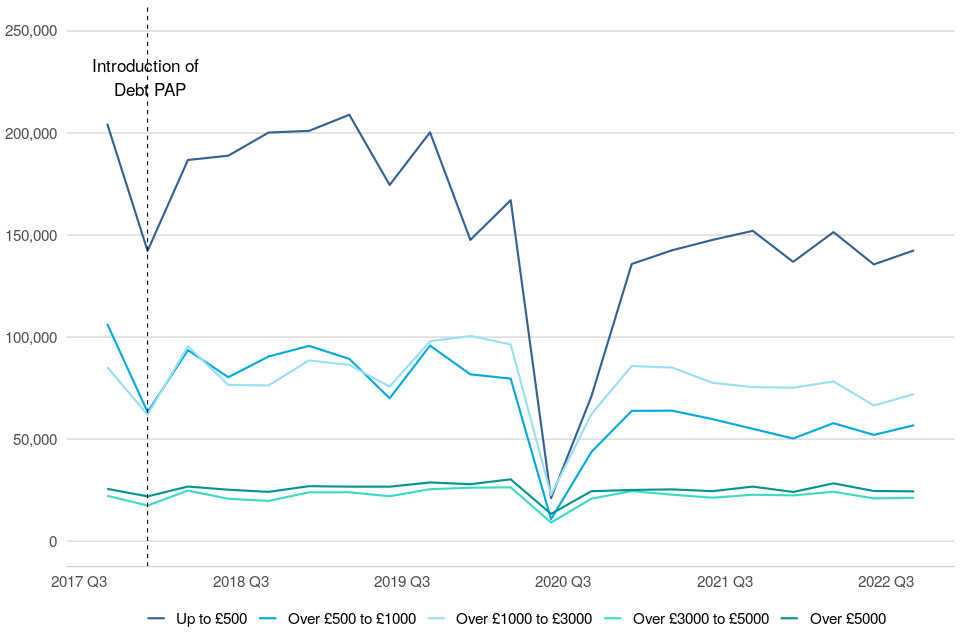
Historically, money claims reached a peak in April to June 2017, after which the implementation of the Pre-Action Protocol (PAP) for Debt Claims in October 2017 led to a sharp drop in claims. An increasing trend resumed the following quarter, suggesting that the impact of the PAP on claim volumes was temporary. The main aim of the protocol is to encourage early engagement between parties to resolve disputes without needing to start court proceedings. In the most recent quarter (July to September 2022), there were 317,000 claims, down 5% on the same quarter in 2021 (332,000 claims).
This quarter, the majority (84%) of money claims were processed and issued at the County Court Business Centre (CCBC). There were 267,000 such claims at the CCBC in July to September 2022 (down 4% on the same quarter in 2021). CCBC claims were particularly affected by Covid-19 and associated actions, recording a more significant decrease than other money claims, but they have now returned to historic trend levels. This is as a result of bulk issuers almost completely ceasing their issue during the immediate response to the pandemic.
The fall in money claims is driven by lower value claims (under £500). These were down 6% to 143,000 claims in the period July to September 2022 compared to the same quarter in 2021, and account for 45% of total money claims in the most recent quarter. This is a return to historical levels with this category also making up 45% of total money claims in July to September 2019.
Other than Q2 2020, damages claims have fluctuated between 26,000 and 40,000 claims each quarter over the last five years (since July to September 2017). However, more recently volumes were down 24% to 26,000 in July to September 2022 compared to the same period in 2021. This was driven by continued decreases in other damages claims, down 59% from 14,000 to 5,500, following steep increases since Q3 2020. These were a result of PPI-related claims that rely on a section of the Consumer Credit Act that relates to unfair relationships[footnote 2] and follows a series of court rulings on the same matter. On the contrary, personal injury claims remained relatively stable, down 2% compared to the same period in 2021 and showing early signs of stabilising, following general decreases since Q4 2020.
4.1 Allocations (table 1.3)
In July to September 2022, 34,000 money and damages claims were allocated to track, down 15% (from 40,000) on the same period in 2021. A decrease was seen across all tracks. This is, in part, due to the fall in money claims issued in recent quarters. Compared to July to September 2021, of these allocations:
- 23,000 were allocated to small claims, down 6% on July to September 2021. This accounts for 68% of all allocations (compared to 61% of all allocations in the same quarter of 2021). This increase in the proportion of cases being allocated to small claims is due to government changes made to the claims process for low value road traffic accident (RTA) related personal injury claims (31st May 2021). As part of the package of measures introduced, the small claims track limit for Personal Injury claims related to RTA’s increased from £1,000 to £5,000. This means that the majority of such claims will now proceed through the small claims track instead of the fast track;
- 8,700 were allocated to fast track, down 32% on July to September 2021. This accounts for 26% of all allocations (compared to 32% of all allocations in the same quarter of 2021);
- 2,100 were allocated to multi-track, down 18% on July to September 2021. This accounts for 6% of all allocations (compared to 7% of all allocations in the same quarter of 2021);
5. Defences (including legal representation) and Trials
The number of claims defended was down 14% to 61,000 compared to the same quarter in 2021.
Of those claims defended, 50% had legal representation for both claimant and defendant, 29% had representation for claimant only, and 4% for defendant only.
The number of trials was down 5% to 13,000 compared to the same quarter in 2021.
Average time taken for small claims was 51.2 weeks (0.6 weeks longer compared to the same quarter in 2021) and for multi and fast track claims it was 75.5 weeks (4.8 weeks longer than July to September 2021).
Of those claims defended in July to September 2022, 50% had legal representation for both claimant and defendant, 29% had representation for claimant only, and 4% for defendant only. Almost all (94%) damages claim defences had legal representation for both the defendant and claimant, compared with 25% of money claim defences.
Figure 3: Proportion of civil defences and legal representation status, July to September 2022 (Source: table 1.6)
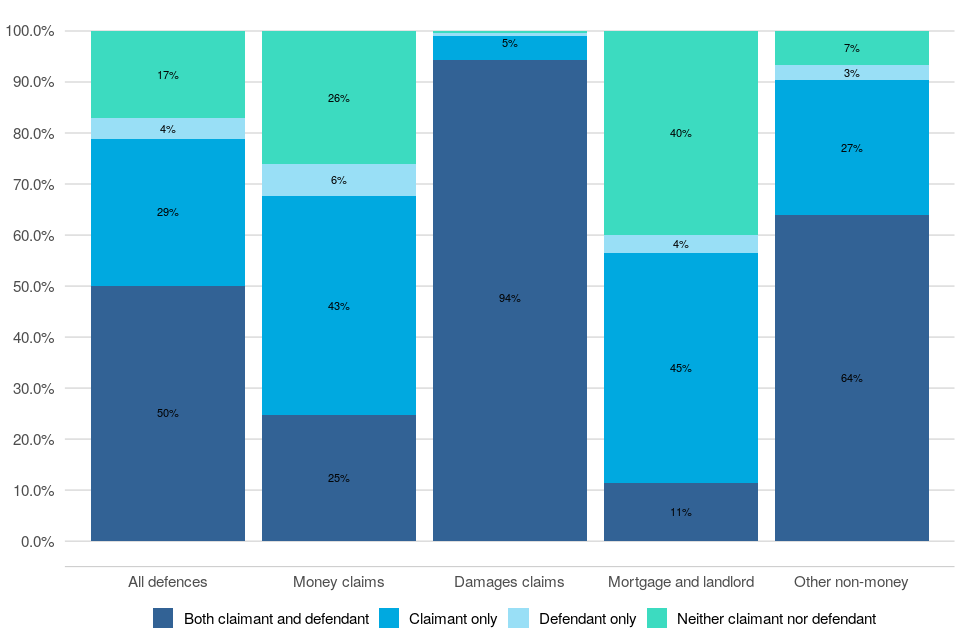
The total number of claims defended was down 14% in July to September 2022 compared to the same quarter in 2021, from 71,000 to 61,000 cases. This was driven by decreases in money and damages claims, with the most significant impact from defended damages claims (down 19% from 27,000 to 22,000). On the contrary, mortgage and landlord possession defences were up 125% from 1,600 to 3,600 compared to July to September 2021.
5.1 Trials and Time Taken to Reach Trial (table 1.5)
Defended cases which are not settled or withdrawn, generally result in a trial. In total, there were 13,000 trials in July to September 2022, down 5% compared to the same period in 2021. Of the claims that went to trial, 10,000 (77%) were small claims trials (up 2% compared to the same quarter in 2021) and 3,000 (23%) were fast and multi-track trials (down 22% from the same quarter of 2021).
Figure 4: Average number of weeks from claim being issued to initial hearing date, Q3 (July to September) 2017 to Q3 (July to September) 2022 (Source: table 1.5)
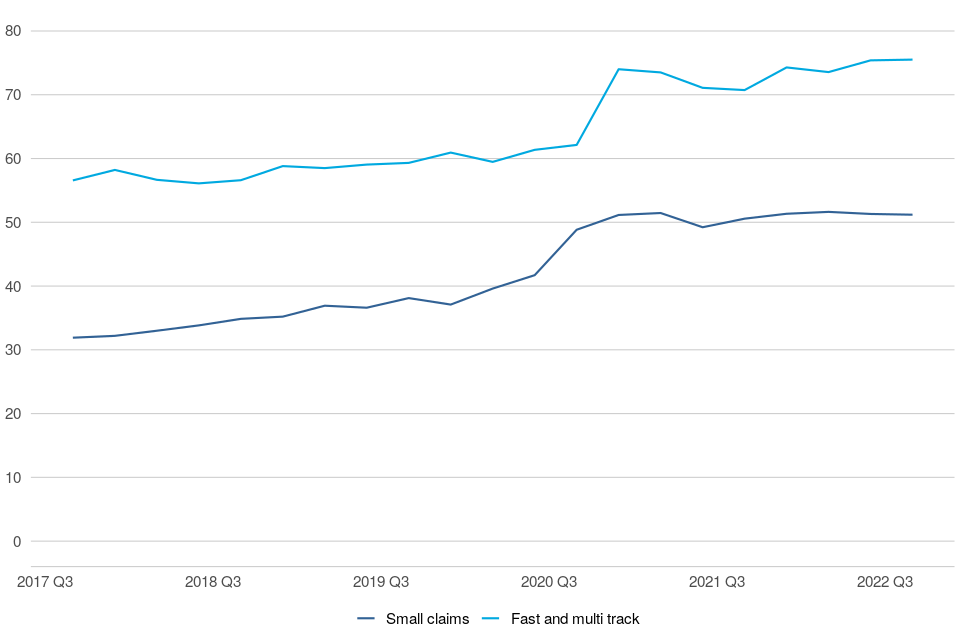
In July to September 2022, it took an average of 51.2 weeks between a small claim being issued and the claim going to trial, 0.6 weeks longer than the same period in 2021.
Small claims were impacted sooner by Covid-19 than fast and multitrack claims, in terms of timeliness, for a number of reasons. These claims have shorter timeframes to begin with, and so delays were observed sooner in the timeliness figures. Small claims may also be less suited to remote hearings as they tend to be in-person claims rather than professional users.
Measures were put in place in response to the challenges of the pandemic to help with the increasing timeliness to resolve small claims including the increased use of small claims mediation and Early Neutral Evaluation (where a judge will try and engineer agreement without any finding on the fact). These measures, when successful, result in outcomes which are not used within the timeliness calculations. This means the final cases used in timeliness measures include a disproportionate number of more complex cases which take longer to dispose of.
For multi/fast track claims, it took on average 75.5 weeks to reach a trial, 4.8 weeks longer than in July to September 2021 – continuing to exceed the upper limit of the range seen in 2009-2019 (52 to 61 weeks).
Covid-19 and associated actions have led to an uptick in time taken for all claims to reach trial. Prior to this, a sustained period of increasing receipts had increased the time taken to hear civil cases and caused delays to case progress. Additional venues have been provided to add temporary capacity to hear cases and help the court and tribunal system to run effectively.
6. Judgments
Judgments were down 21% compared to same quarter in 2021
There were 225,000 judgments made in July to September 2022, compared to 286,000 in the same quarter of 2021. Of these judgments, 204,000 (91%) were default judgments.
Figure 5: All claims, judgments and default judgments, Q3 (July to September) 2017 to Q3 (July to September) 2022 (Source: tables 1.2 and 1.4)

There were 225,000 judgments made in July to September 2022, down 21% compared to the same quarter of 2021. Of these, 91% were default judgments, down 1pp on its share in July to September 2021. These have remained relatively stable since 2018, with around 9 out of every 10 judgments resulting in a default judgment.
The second largest type of judgment was ‘admissions’[footnote 3], of which there were 12,000 in July to September 2022, down 18% on the same quarter in 2021 (from 15,000). ‘Admission’ judgments accounted for 5% of all judgments.
7. Warrants and Enforcements
Warrants issued were up 11% when compared to same quarter in 2021
In July to September 2022, 76,000 warrants were issued, up 11% from 69,000 in the same quarter of 2021. Of these, 65,000 (85%) were warrants of control, up 3% compared to the same period in 2021.
Enforcement applications were down 19% and enforcement orders were down 22% when compared to July to September 2021
All application categories were down on July to September 2021. Attachment of earnings (AoE) applications were down 21% (from 9,100 to 7,200), while AoE orders were down 12% (from 3,600 to 3,200).
Figure 6: Warrants and enforcements issued – Q3 (July to September) 2017 to Q3 (July to September) 2022 (Source: tables 1.7 and 1.8)
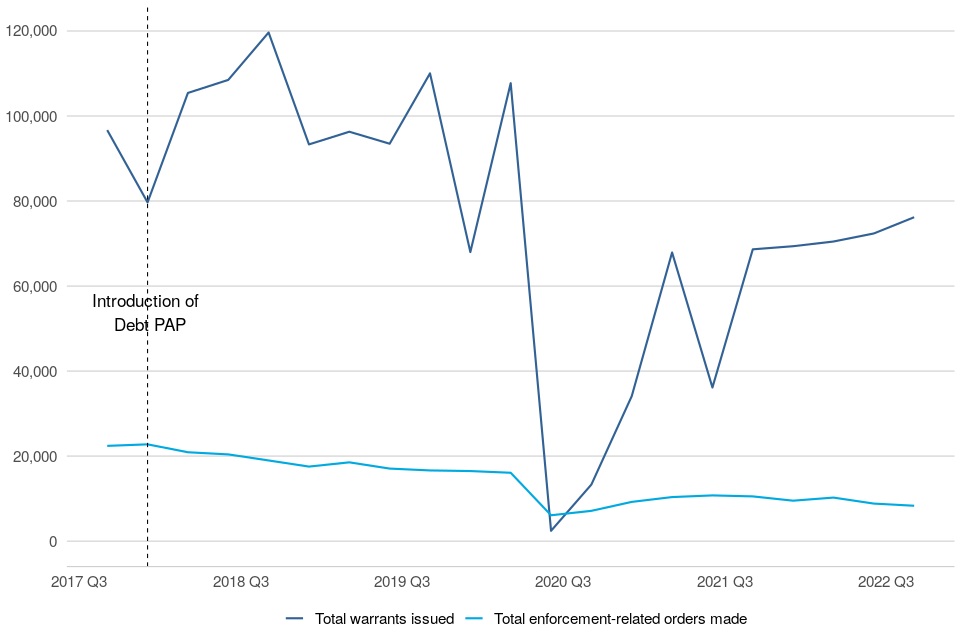
7.1 Warrants (table 1.7)
In the latest quarter (July to September 2022) there were 76,000 warrants issued, up 11% (from 69,000) on the same quarter in 2021; this increase is caused by the relatively low volume of warrants of control in Q2 2021 due to the impact of Covid-19 and related actions. Warrants of control accounted for 85% of total warrants, and were up 3%, from 63,000 to 65,000, compared to the same period in 2021.
There were 11,000 possession warrants issued in July to September 2022, up 92% (from 5,900) on the same quarter in 2021. These have continued a general upwards trend since Q3 2020, following a sharp drop in Q2 2020 due to the impact of Covid-19.
7.2 Enforcements (table 1.8)
In July to September 2022, there were 12,000 enforcement-related order applications (which include attachment of earnings orders, charging orders, third party debt orders, administration orders, and orders to obtain information), down 19% compared to the same quarter of 2021. All application types were down, in particular, attachment of earnings (AoE) applications were down 21% (from 9,100 to 7,200).
There were 8,300 enforcement-related orders made in July to September 2022, down 22% compared to the same quarter of 2021. Orders fell across all types except third party debt orders which were up 3% compared to the same quarter of 2021. The decrease was driven by charging orders which were down 28% (from 5,000 to 3,600).
Over the longer term, there has been a decreasing trend in enforcement-related applications received and orders made since 2009, possibly due to claimants’ preference for using warrants instead to retrieve money, property or goods.
8. Judicial reviews[footnote 4],[footnote 5]
There were 640 judicial review applications received in Q3 2022, up 16% on Q3 2021 (550) and down 24% on Q3 2019 (from 840) as a pre-Covid19 baseline.
Of the 640 applications received in Q3 2022, 18% have already closed, and 8 were found to be ‘Totally Without Merit’ (6% of cases that reached the permission stage).
Figure 7: Judicial Review Applications, by type; Q3 2015 to Q3 2022 (Source: JR CSV)
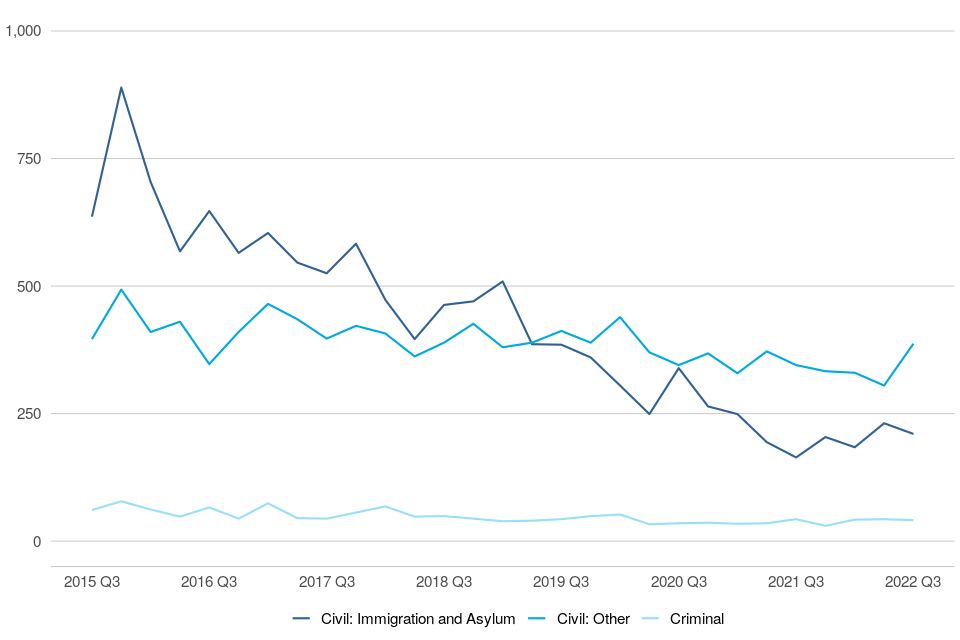
Quarterly JR Receipts – July to September 2022:
Of the 640 applications received in Q3 2022, 210 were civil immigration and asylum applications, 390 were civil (other), and 41 were criminal, up 28%, up 12% and down 5% respectively on Q3 2021. 6 of the civil immigration and asylum cases have since been transferred to the UTIAC.
Of the applications that were made in Q3 2022, 18% are now closed. Of the total applications, 130 reached the permission stage in Q3 2022, and of these:
- 6% (8) were found to be totally without merit.
- 54 cases have already been granted permission to proceed and 70 were refused at the permission stage. 1 of the cases refused at permission stage went on to be granted permission at the renewal stage.
- 55 cases were assessed to be eligible for a final hearing and of these, 3 have since been heard.
- the mean time from a case being lodged to the permission decision was 40 days. Although timeliness for cases being lodged to final hearing are included in the tables, this is based on too few cases to be meaningful. The actual time taken for these cases will only be known when they have had time to work their way through the system.
8.1 Applications lodged against departments (table 2.5)
Table 2.5 presents judicial review figures by defendant type (i.e. individual government department or public body). This table provides the number of judicial review applications lodged, permission granted to proceed to final hearing, and decisions found in favour of the claimant at final hearing.
The information presented is derived from the ‘defendant name’ – a free text field completed by the claimant, which is matched and grouped by department. All efforts have been made to quality assure the data presented. However, this is a manually typed field, and as such is open to inputting errors and should be used with caution.
The key findings for Q3 2022 are:
- The Home Office had the largest number of JR applications lodged against them, with 185 applications. Of these, 9 were granted permission to proceed to final hearing (5% of applications) to date.
- The second largest recipient of JR cases was the Local Authorities, with 163 cases received, of which to date 27 were granted permission to proceed to final hearing (17% of applications).
- The third largest recipient was the Ministry of Justice, having 158 applications lodged against it. Of these, 11 were granted permission to proceed to final hearing (7% of applications) to date.
A more granular view of the JR data by department and case type can be found in the data visualisation tool found here. Feedback is welcome on this tool to ensure it meets user needs.
9. Further information
9.1 Provisional data and revisions
The statistics in the latest quarter are provisional and revisions may be made when the next edition of this bulletin is published. If revisions are needed in subsequent quarters, these will be annotated in the tables.
9.2 Accompanying files
As well as this bulletin, the following products are published as part of this release:
- A supporting document providing further information on how the data is collected and processed, as well as information on the revisions policy and legislation relevant to civil justice.
- The quality statement published with this guide sets out our policies for producing quality statistical outputs for the information we provide to maintain our users’ understanding and trust.
- A set of overview tables (also available in accessible format) and CSV files, covering each section of this bulletin.
- A set of tables providing statistics on the Business and Property Courts of England and Wales, also available in accessible format.
- A JR data visualisation tool (to provide a more granular view of the JR data by department and case type). This can be found here.
- A sankey tool which shows case progression of civil cases in the county courts is here.
9.3 Rounding convention
Figures greater than 10,000 are rounded to the nearest 1,000, those between 1,000 and 10,000 are rounded to the nearest 100 and those between 100 to 1,000 are rounded to the nearest 10. Less than 100 are given as the actual number.
9.4 National Statistics status
National Statistics status means that official statistics meet the highest standards of trustworthiness, quality and public value.
All official statistics should comply with all aspects of the Code of Practice for Official Statistics. They are awarded National Statistics status following an assessment by the Authority’s regulatory arm. The Authority considers whether the statistics meet the highest standards of Code compliance, including the value they add to public decisions and debate.
It is the Ministry of Justice’s responsibility to maintain compliance with the standards expected for National Statistics. If we become concerned about whether these statistics are still meeting the appropriate standards, we will discuss any concerns with the Authority promptly. National Statistics status can be removed at any point when the highest standards are not maintained, and reinstated when standards are restored.
9.5 Future publications
Our statisticians regularly review the content of publications. Development of new and improved statistical outputs is usually dependent on reallocating existing resources. As part of our continual review and prioritisation, we welcome user feedback on existing outputs including content, breadth, frequency and methodology. Please send any comments you have on this publication including suggestions for further developments or reductions in content.
9.6 Contacts
Press enquiries should be directed to the Ministry of Justice (MoJ) press office:
Sebastian Walters - email: sebastian.walters@justice.gov.uk
Other enquiries about these statistics should be directed to the Data and Evidence as a Service division of the Ministry of Justice:
Laura Jones - email: cajs@justice.gov.uk
Next update: 2 March 2023
-
Following the alignment of the fees for online and paper civil money and possession claims in May 2021, figure 2 shows all data with the updated claim brackets for comparison, a further breakdown of these brackets is available within the CSV. The CSV shows updated claim brackets from 2021. ↩
-
Judgment by admission is where the defendant admits the truth of the claim made. ↩
-
The judicial review data are Official Statistics ↩
-
Quarterly judicial review figures have been added to the bulletin and accompanying CSVs for a more granular breakdown of this data. ↩
